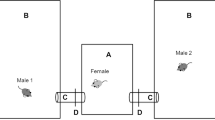Abstract
We review our studies of mate choice with two MHC‐congenic strains of mice. This work was stimulated by findings from Yamazaki and colleagues showing that male mice exhibited mate preferences for females whose MHC‐haplotype was different from their own, while female mice exhibited either no preference or a weak preference for males of a particular MHC‐haplotype (see Beauchamp et al., 1988). Since these findings were unexpected (mate choice theory predicts that females will be more selective than males), we studied the preferences of mice from two additional MHC‐congenic strains to assess the generality of the previous findings. Specifically, the goals of our research were: (1) to determine the mate preferences of congenic mice with MHC‐haplotypes derived from wild populations, (2) to compare the mate preferences of male and female mice in a test situation where each sex has a clear opportunity to make a choice, and (3) to estimate effects of cross‐fostering on each sex.
Similar content being viewed by others
References
Beauchamp, G.K., K. Yamazaki, J. Bard & E.A. Boyse, 1988. Preweaning experience in the control of mating preferences by genes in the major histocompatibility complex of the mouse. Behav. Genet. 18: 537-547.
Brown, R.E., P.B. Singh & B. Roser, 1987. The major histocompatibility complex and the chemosensory recognition of individuality in rats. Physiol. Behav. 40: 65-73.
Egid, K. & J.L. Brown, 1989. The major histocompatibility complex and female mating preferences in mice. Anim. Behav. 38: 548-550.
Eklund, A., K. Egid & J.L. Brown, 1991. The major histocompatibility complex and mating preferences of male mice. Anim. Behav. 42: 693-694.
Thomas, L., 1974. Biological signals for self-identification, pp. 239-247 in Progress in Immunology II, edited by L. Brent and J. Holoborow. Elsevier, Amsterdam.
Trivers, R.L., 1972. Parental investment and sexual selection, pp. 136-179 in Sexual Selection and the Descent of Man 1871- 1971, edited by B. Campbell. Aldine, Chicago.
Wakeland, E.K. & J. Klein, 1979. The histocompatibility-2 system in wild mice: VII. Serological analysis of 29 wild-derived H-2 haplotypes using antisera to inbred I-region antigens. Immunogenetics 8: 27-39.
Yamaguchi, M., K. Yamazaki, G.K. Beauchamp, J. Bard, L. Thomas & E.A. Boyse, 1981. Distinctive urinary odors governed by the major histocompatibility locus of the mouse. Proc. Natl. Acad. Sci. USA 78: 5817-5820.
Yamazaki, K., E.A. Boyse, V. Mike, H.T. Thaler, B.J. Mathieson, J. Abbot, J. Boyse & Z.A. Zayas, 1976. Control of mating preferences in mice by genes in the major histocompatibility complex. J. Exp. Med. 144: 1324-1335.
Yamazaki, K., M. Yamaguchi, L. Baranoski, J. Bard, E.A. Boyse & L. Thomas, 1979. Recognition among mice. J. Exp. Med. 150: 755-760.
Yamazaki, K., G.K. Beauchamp, D. Kupniewski, J. Bard, L. Thomas & E.A. Boyse, 1988. Familial imprinting determines H-2 selective mating preferences. Science 240: 1331-1332.
Author information
Authors and Affiliations
Rights and permissions
About this article
Cite this article
Arcaro, K.F., Eklund, A. A review of MHC‐based mate preferences and fostering experiments in two congenic strains of mice. Genetica 104, 241–244 (1998). https://doi.org/10.1023/A:1026465421201
Issue Date:
DOI: https://doi.org/10.1023/A:1026465421201




